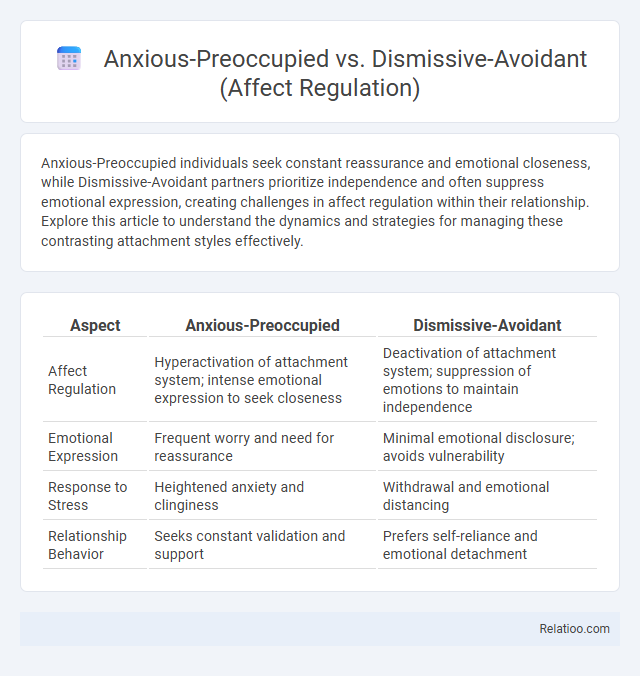Anxious-Preoccupied individuals seek constant reassurance and emotional closeness, while Dismissive-Avoidant partners prioritize independence and often suppress emotional expression, creating challenges in affect regulation within their relationship. Explore this article to understand the dynamics and strategies for managing these contrasting attachment styles effectively.
Table of Comparison
| Aspect | Anxious-Preoccupied | Dismissive-Avoidant |
|---|---|---|
| Affect Regulation | Hyperactivation of attachment system; intense emotional expression to seek closeness | Deactivation of attachment system; suppression of emotions to maintain independence |
| Emotional Expression | Frequent worry and need for reassurance | Minimal emotional disclosure; avoids vulnerability |
| Response to Stress | Heightened anxiety and clinginess | Withdrawal and emotional distancing |
| Relationship Behavior | Seeks constant validation and support | Prefers self-reliance and emotional detachment |
Understanding Attachment Styles: Anxious-Preoccupied vs Dismissive-Avoidant
Understanding attachment styles is crucial for effective affect regulation as Anxious-Preoccupied individuals often experience heightened emotional intensity and seek constant reassurance, which can challenge emotional balance. In contrast, Dismissive-Avoidant individuals tend to suppress emotional needs and maintain distance, leading to difficulties in expressing vulnerability and managing emotional stress. Your ability to recognize these patterns in yourself or others enhances emotional awareness and promotes healthier relationships through tailored affect regulation strategies.
Core Differences in Affect Regulation
Anxious-Preoccupied attachment involves heightened emotional sensitivity and difficulty managing distress, leading to intense seeking of reassurance to regulate negative feelings. Dismissive-Avoidant attachment is characterized by emotional suppression and detachment, with individuals downplaying their needs to maintain independence and minimize vulnerability. Your affect regulation differs fundamentally between these styles, with anxious-preoccupied focusing on hyperactivation of emotions and dismissive-avoidant emphasizing deactivation strategies to control affective responses.
Emotional Responses in Anxious-Preoccupied Individuals
Anxious-preoccupied individuals exhibit heightened emotional responses characterized by intense fear of rejection and persistent need for reassurance, which complicates effective affect regulation. Their hyperactivation strategy amplifies emotional distress, leading to difficulty in calming down after conflicts or perceived abandonment. Your ability to recognize these patterns can improve emotional management and foster healthier interpersonal relationships.
Emotional Detachment in Dismissive-Avoidant Types
Dismissive-avoidant attachment is characterized by emotional detachment and a strong tendency to suppress feelings to maintain independence, contrasting sharply with the anxious-preoccupied style, which involves hyperactivation of emotions and fear of abandonment. Your affect regulation strategies may lean toward minimizing emotional expression, leading to difficulties in forming deep, trusting relationships. Understanding these patterns can help manage emotional responses and improve interpersonal connections.
Coping Mechanisms and Defense Strategies
Anxious-Preoccupied individuals often cope with stress through hypervigilance and seeking constant reassurance, reflecting their heightened affect dysregulation and fear of abandonment. Dismissive-Avoidant types employ suppression and emotional distancing as primary defense strategies to manage their affect, prioritizing self-reliance while minimizing vulnerability. Your ability to recognize these distinct affect regulation mechanisms enhances emotional awareness and promotes healthier coping techniques to address interpersonal challenges effectively.
Impact on Communication and Intimacy
Anxious-Preoccupied attachment leads to heightened emotional expression and a strong desire for closeness, which can cause communication to feel intense or overwhelming for partners. Dismissive-Avoidant individuals regulate affect by minimizing emotional expression, often creating distance that hampers emotional intimacy and open communication. Your ability to foster healthy relationships depends on recognizing these patterns and adapting your communication style to balance emotional needs and create secure intimacy.
Triggers and Stress Responses
Anxious-Preoccupied attachment triggers intense worry about abandonment, causing heightened emotional arousal and seeking excessive reassurance, while Dismissive-Avoidant attachment leads to emotional suppression and distancing as a stress response to perceived threats. Your affect regulation becomes a critical factor in managing these reactions, with anxious-preoccupied individuals struggling to modulate fear and dismissive-avoidant individuals suppressing distress to maintain control. Understanding these distinct triggers and stress responses helps tailor effective strategies for emotional balance and relational health.
Relationship Dynamics and Conflict Patterns
Anxious-Preoccupied attachment is characterized by heightened emotional sensitivity and a fear of abandonment, leading to clinginess and persistent reassurance-seeking in relationship dynamics and conflict patterns. Dismissive-Avoidant attachment involves emotional distancing and suppression of feelings, resulting in detachment and withdrawal during conflicts to maintain autonomy. Affect regulation in these attachment styles shapes how individuals manage stress and intimacy, with anxious-preoccupied individuals amplifying emotional expression, while dismissive-avoidant individuals inhibit it, influencing communication and resolution outcomes.
Strategies for Healthier Affect Regulation
Anxious-preoccupied individuals often employ hyperactivation strategies such as excessive reassurance-seeking and rumination to manage emotional distress, whereas dismissive-avoidant persons typically use deactivation strategies including emotional suppression and withdrawal to regulate affect. Your path to healthier affect regulation involves cultivating awareness of these patterns and adopting adaptive techniques like mindfulness, emotional validation, and secure attachment behaviors. Implementing these strategies enhances emotional resilience by fostering balanced emotional expression and reducing maladaptive stress responses.
Moving Toward Secure Attachment
Anxious-Preoccupied and Dismissive-Avoidant attachment styles represent contrasting affect regulation strategies where the former involves hyperactivation of emotions to seek closeness, while the latter suppresses emotions to maintain distance. You can move toward secure attachment by developing emotional awareness, practicing consistent self-soothing techniques, and fostering open communication to balance vulnerability and independence. Enhancing affect regulation skills enables healthier relationships and emotional resilience.

Infographic: Anxious-Preoccupied vs Dismissive-Avoidant (Affect Regulation)
 relatioo.com
relatioo.com